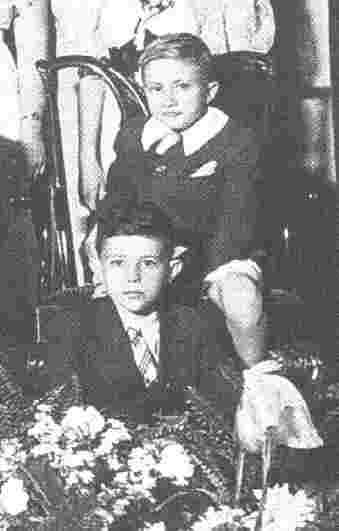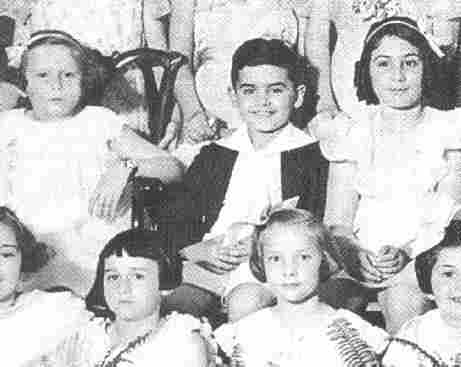
Figure 1.--This boy wears his suit jacket with a rather formal Eton collar and white short pants. Eton collars were going out of style in the 1930s, but were still worn for formal occasions. His jacket is the rather juvevile style without lapels.

Periodically music teachers would hold recitals for the children. The boys would
always be dressed in their best suits. Mothers considered these very important
occasions, the children were well scrubbed and decked out inntheir best dresses and suits. Some boys in the 1920s, especially the early 1920s still wore Eton collars. Boys suits were quite varied in the inter-war period. Depending on the family, country, and age, a boy might wear short pants, knickers, or long pants. Kneepants suits were still sold in the early 1920s, but soon disappeared. Knickers were especially popular in the 1920s, but began to decline in popularity in the 1930s, although they were still widely worn in America. Short paonts were almost universally worn by younger European boys.
Almost invairably mothers still insisted on formal attire for boys performing at their reciatals. The trend toward informal clothes, however, can even be seen in these recitals. Some boys during the summer in the 1930s began wearing open necked shirts without ties.
Eton collars were still common in the early 1920s, but declined significantly in popularity as the decade progressed. While they were still seen as late as the lart 1930s, soft collars had long since replaced them. Some stylish mothers, however, persisted in thinking that a formal suit still required an stiff Eton collar. Eton collars, especially in England, were considered necessary for very formal occasions. While most boys wore soft collars that buttoned at the neck and a tie, a new more casual style developed in the 1930s. Boys began wearing an open collar shirt with a wide lapel. This shirt could be worn informally with a sports jacket without buttoning it or adding a tie. It was a particularly popular summer style.
Boys durin the inter-war years stopped wearing kneepants suits to their recitals, but short pants, knicker, and long pants suits were worn.
The Fauntleroy suit was a 19th century fashion thay continued into the early 20th century. Actuaal Fauntleroy suits were not commonly seen after World War I (1914-18), the style began to be seen as frivolous. We do, however, notice boys outfists that have eklements of the Fauntleroy style, especailly during the early 1920s. Mothers often used such styling in the early 1920s, although by the end of the decade more standard suits styles had become more common for at reciatals.
Short pants suits appeared in the 1910s and had become quite common in Europe,
but less so in America during the 1920s. Short pants were wirn year round by British and
some other European boys, but were more seasonal in America. They became somewhat
more common in America during the 1930s, but for younger boys. They were very
often worn with short ankle socks rather than kneesocks. Boy during the summer might wear their suit jackets with white or light-colored short pants. Ankle socks were particularly common in the summer. Younger boys in America might wear Eton suits, lapelless jackets worn with Eton collars.
Almost all Americam boys wore knicker suits in the 1920s, often wearing them above the knees. This was a carry over from the 1900-1920 period when almost all bys wiore knee pants and knickers--even older high school boys. Knickers were also worn on the Continent by older boys, but less commonly in England. By the 1930s, however,
they were mostly worn by grade-school boys.

Figure 2.--This boys also wears a suit jacket with white short pants. Note the open collar style that was becoming popular by the mid-1930s. |
More and more American boys were wearing long pants suits in the 1930s, especially
older boys in high school. But even many grade school boys were wearing long pants by the
early 1940s.
Navigate the Historic Boys' Clothing Web Site:
[Return to the Main inter-war years instrumental music page]
[Introduction]
[Activities]
[Bibliographies]
[Biographies]
[Chronology]
[Clothing styles]
[Contributions]
[FAQs]
[Glossaries]
[Boys' Clothing Home]
Related Chronolgy Pages in the Boys' Historical Web Site
[Main Chronology Page]
[The 1880s]
[The 1930s]
[The 1940s]
[The 1950s]
[The 1960s]
[The 1970s]
[The 1980s]
Navigate the Historic Boys' Clothing Web style pages:
[Fauntleroy suits]
[Kilts]
[Caps]
[Sailor suits]
[Sailor hats]
[School uniform
[Scout
